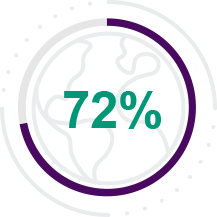
CAN EVOLVING TECHNOLOGY
HELP YOU STAY AHEAD OF YOUR COMPETITORS?


CONTROLLING COSTS
is a critical factor in the success of your mill. And the pressure on your operations is only increasing as several important trends play out.
Initial adopters like your company started using enzymes early on in order to avoid the negatives associated with refining in tissue. This gave you an advantage over your competition, but there were still some negatives.
![]()
YESTERDAY’S ENZYME PRODUCTS WERE NOT COMPATIBLE WITH WET STRENGTH RESIN
![]()
YESTERDAY’S ENZYME PRODUCTS WERE NOT COMPATIBLE WITH WET STRENGTH RESIN
This meant that your towel and facial grades could not benefit from enzymatic technology.
![]()
![]()
THESE PRODUCTS USED A GENERIC ENZYME WHICH IS LESS EFFICIENT
![]()
THESE PRODUCTS USED A GENERIC ENZYME WHICH IS LESS EFFICIENT
This means that you couldn’t get full efficiency from the enzyme because the products had to work across all fiber types.
![]()
![]()
EARLY TECHNOLOGY DID NOT ALLOW FOR MONITORING ENZYME ACTIVITY IN THE PROCESS
![]()
EARLY TECHNOLOGY DID NOT ALLOW FOR MONITORING ENZYME ACTIVITY IN THE PROCESS
This made it difficult to optimize or even know if the enzyme was working properly.
![]()
In this environment, every dollar counts, including what you spend on enzymatic and other chemical products to achieve strength.

What percentage of consumers report actively buying more environmentally-friendly products than they did five years ago?


Sorry!
TRY AGAIN.


You Are Correct!
What’s more, 81% say they expect to buy even more environmentally-friendly products over the next five years.



Sorry!
TRY AGAIN.
Market demands for strength and softness will continue to rise, as will energy and fiber costs. The conventional responses to these external pressures might be to use methods other than enzymes. But what are the hidden risks of these methods?
![]()
WHAT ARE THE RISKS?
![]()
WHAT ARE THE RISKS?
- Will you return to more refining?
- Will you resort to more expensive fibers like NBSK or Eucalyptus?
- Will you have to apply softeners, dry strengths or other chemistries?
All of these methodologies will increase your cost base once again.
But what if you could get more fibrillation from your fiber?
To get there, you must overcome two main challenges:
the shortcomings of yesterday’s enzymes and choosing the right supplier to partner with for enzymatic technology. Which of these challenges is the most pressing for your mill?
![]()
THE SHORTCOMINGS OF YESTERDAY’S ENZYMES
![]()
![]()
CHOOSING THE RIGHT SUPPLIER TO PARTNER WITH FOR ENZYMATIC TECHNOLOGY
![]()

1. Industry Trends in Graphic Paper, Mark Rushton, Paper360, December 2017
2. Most Consumers Want Sustainable Products and Packaging, Andrew Martins, Business News Daily, June 4, 2019